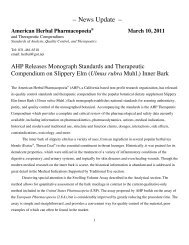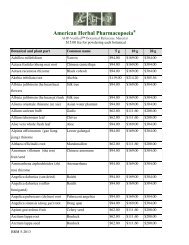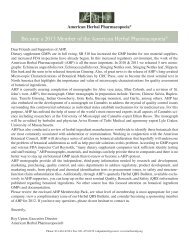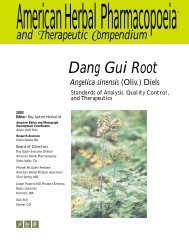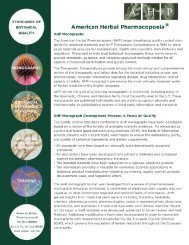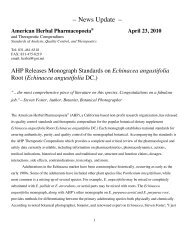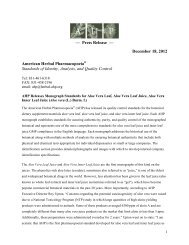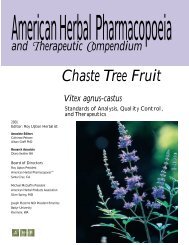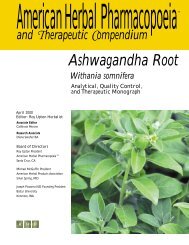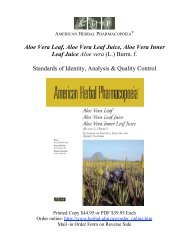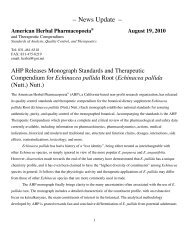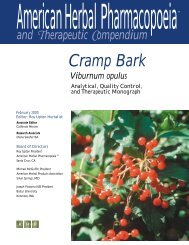alerian oot - American Herbal Pharmacopoeia
alerian oot - American Herbal Pharmacopoeia
alerian oot - American Herbal Pharmacopoeia
Create successful ePaper yourself
Turn your PDF publications into a flip-book with our unique Google optimized e-Paper software.
V<strong>alerian</strong> Infusion<br />
Hot Infusion: 2-3 g of v<strong>alerian</strong> steeped in 225 mL of boiled water for 10-15<br />
minutes in covered vessel (Bradley 1992).<br />
Cold Infusion: 2-3 g of v<strong>alerian</strong> soaked in 225 mL of cold water for 6-8 hours<br />
(Osol and others 1947).<br />
In a limited number of analyses, teas prepared from V. officinalis were found to<br />
contain valerenic acid and its derivatives and very low levels or no valepotriates (Bos<br />
1997).<br />
V<strong>alerian</strong> Tincture<br />
V<strong>alerian</strong> tinctures are official in the Dutch, German, and Swiss pharmacopoeiae,<br />
prepared either by maceration or percolation at a concentration of 1 part herb to 5<br />
parts water-alcohol menstruum (70% ethanol V/V). Characteristics: Dark brown liquid<br />
with a strong characteristic v<strong>alerian</strong> smell and taste.<br />
The German pharmacopoeia requires the finished tincture to yield a minimum<br />
of 3% (w/w) dry residue as determined on 3.00 g tincture as described in the monograph<br />
for tinctures. The Swiss pharmacopoeia requires the finished tincture to yield<br />
0.06% essential oil. Storage: Store in tightly closed containers protected from light.<br />
Note: Valerenic acid derivatives begin to be extracted at alcohol concentrations above 30% and are relatively constant<br />
above 50%. Valepotriates are only extractable at alcohol concentrations above 70%.<br />
V<strong>alerian</strong> Fluid Extract<br />
Prepared either by maceration or percolation at a concentration of 1 part herb to 1<br />
part water-alcohol menstruum (70% ethanol V/V) (Bos 1997). Characteristics: Dark<br />
brown liquid with a strong characteristic v<strong>alerian</strong> smell and taste. Storage: Store in<br />
tightly closed containers protected from light.<br />
V<strong>alerian</strong> R<strong>oot</strong> Dried Extract According to the German <strong>Pharmacopoeia</strong><br />
(Deutsches Arzneibuch 10 1993)<br />
Prepared from the chopped r<strong>oot</strong>s of v<strong>alerian</strong> and 70% ethanol (V/V) as described in<br />
the v<strong>alerian</strong> extract monograph. The relationship of the drug to the extract is between<br />
4:1 and 7:1. Characteristics: Brown, hygroscopic, powder or pulverized mass with<br />
intense characteristic aroma. Loss of Moisture on Drying: At most 5%. Storage:<br />
Protect from moisture and light.<br />
C ONSTITUENTS<br />
The r<strong>oot</strong>s of V. officinalis contain several compounds with demonstrable pharmacological<br />
activity. These include the essential oil and its sesquiterpenoids (valerenic<br />
acid), epoxy iridoid esters (valepotriates) and their decomposition products such as<br />
baldrinal and homobaldrinal, amino acids (arginine, GABA, glutamine, tyrosine),<br />
and alkaloids. V<strong>alerian</strong> also possesses small amounts of phenolic acids and flavonoids,<br />
valerosidatum, chlorogenic acid, caffeic acid, choline, β-sitosterol, fatty acids, and<br />
various minerals.<br />
Essential Oil (0.1% to 0.6%)<br />
The essential oil content and composition of v<strong>alerian</strong> varies significantly. Most pharmacopoeial<br />
standards require that v<strong>alerian</strong> contain a minimum of 0.5% essential oil<br />
based on dry weight. Very few studies have been conducted on fresh material with the<br />
most recent published report finding approximately 0.25% essential oil (Hendriks<br />
and others 1981).<br />
The essential oil contains mono- and sesquiterpene hydrocarbons with the main<br />
constituents being bornyl acetate, v<strong>alerian</strong>ol, valeranone, cryptofauronol, and valerenal,<br />
depending on the chemovar. The sesquiterpenes have three types of structures<br />
based on kessane, valeranone, and valerenic acid skeletons. Valerenic acid and its<br />
derivatives (acetoxyvalerenic acid and hydroxyvalerenic acid) have been reported to<br />
be characteristic of V. officinalis and its subspecies (Hänsel and Schulz 1982).<br />
However, species other than those considered as part of the aggregate have also been<br />
<strong>American</strong> <strong>Herbal</strong> <strong>Pharmacopoeia</strong> • V<strong>alerian</strong> R<strong>oot</strong> • April 1999 Page 7



